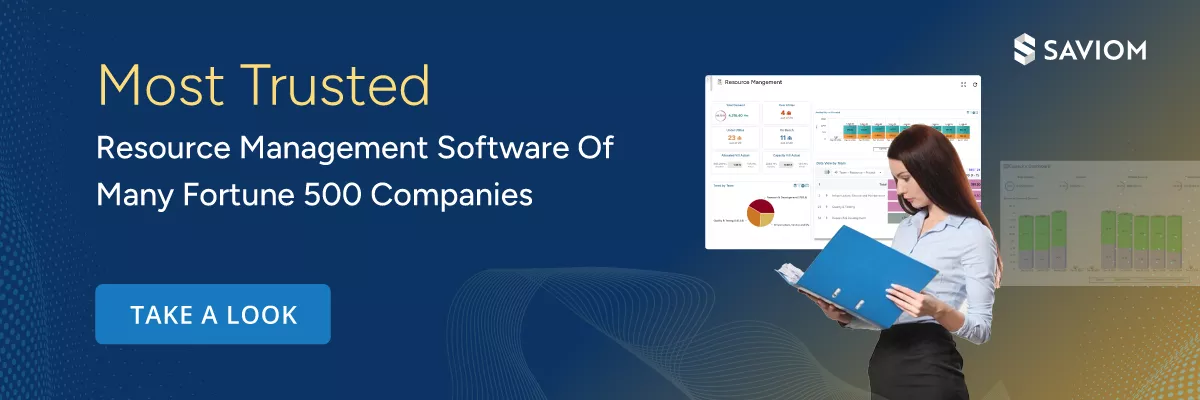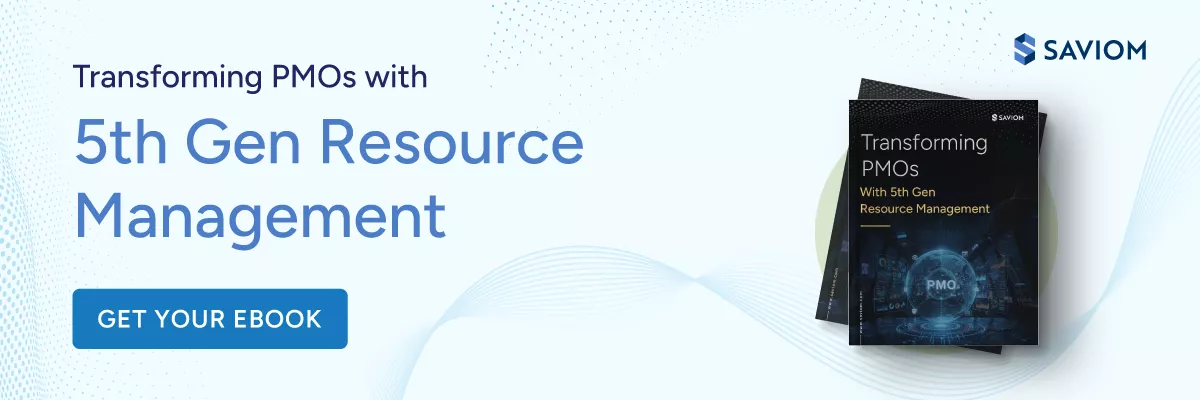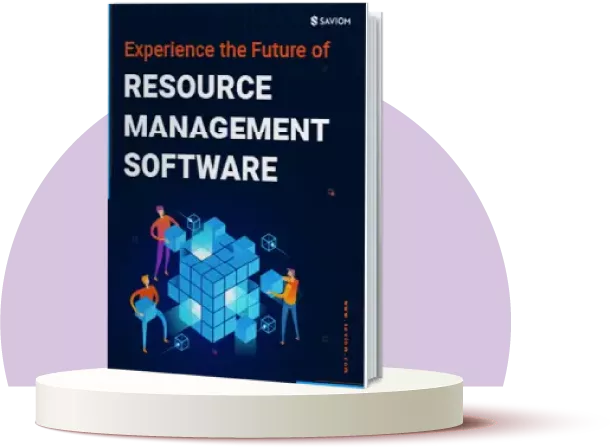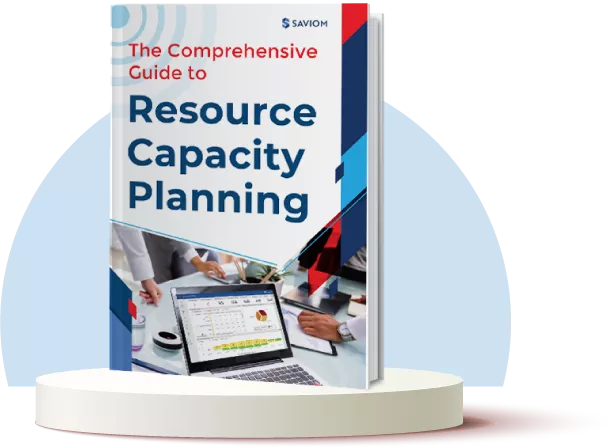Across organizations, the signs are strikingly familiar: timeline delays, rising employee burnout, budget overruns, and projects that constantly fall short of client expectations. These recurring issues arise from fragmented data, inconsistent resource planning, and a lack of visibility into capacity, skills, and workload distribution.
Project Resource Management (PRM) helps eliminate this blind spot. With multi-dimensional resource forecasting, real-time visibility, and standardized planning practices, PRM gives organizations the insights they need to utilize resources effectively across all projects. It replaces reactive decision-making with proactive governance, ensuring healthy workloads, reducing delivery delays, and enhancing financial returns.
This guide will walk you through every stage of that transformation, from mastering intelligent resource allocation and advanced capacity planning to exploring best practices, tools, and future trends that elevate your PMO’s performance.
Let’s start with the fundamentals:
What is Project Resource Management (PRM)?
Project Resource Management (PRM) is the structured process of planning, allocating, and managing resources, such as people, skills, time, and tools, specifically within the context of individual projects or project portfolios. Its goal is to ensure that the right resources are assigned to the right tasks at the right time to achieve project objectives efficiently and profitably.
Unlike enterprise resource management, which take a broader, organization-wide view of resource optimization across all business functions and departments, PRM focuses on the project lifecycle, from initiation to closure. It emphasizes aligning resource capacity and capability with project schedules, budgets, and deliverables to maintain productivity, avoid over- or underutilization, and meet client expectations.
In essence, project resource management (PRM) is about ensuring project success through precise, data-driven control of resource capacity and demand within project constraints.
Now that we understand what project resource management is, let’s take a look at its core components.
Core Components of an Effective PRM Framework
A robust PRM framework moves resource management out of spreadsheets and into a strategic, enterprise-wide function. It requires several interconnected components to function effectively:
- Centralized Resource Pool for Projects & Portfolios: A single source of truth for capturing all resources, skills, availability, and current workloads across the entire organization.
- Skills Inventory Aligned to Strategic Priorities: A comprehensive database of competencies, certifications, and experience, crucial for finding the best-fit resource for every project.
- Portfolio-Level Demand Forecasting & Capacity Planning: The ability to predict future resource needs based on the project pipeline and compare them against current and future capacity.
- Standardized Resource Request & Allocation Workflow: Formal, transparent, and consistent processes for how project managers request resources and how resource managers approve and assign them.
- Scenario Modeling for Constraint Resolution: “What-if” analysis capabilities to test different resource allocation strategies before implementation, resolve potential conflicts in advance, and choose the most efficient, cost-effective resource management plan.
- Workload Balancing Across Projects & Programs: Techniques to ensure no individual or team is chronically overloaded or underutilized, thus preventing burnout and ensuring teams operate at healthy productivity levels.
- Resource Cost Management Linked to Portfolio Budgets: Tracking the resource cost rate and linking their usage directly to project and portfolio financial plans.
- Utilization Tracking with PMO Dashboards: Real-time visibility into how resources are spending their time (billable, non-billable, overhead), providing data for continuous optimization.
- Early Warning & Risk Management Across Portfolio: Metrics and alerts that flag potential resource bottlenecks or conflicts before they impact project delivery.
- Integration with PPM Tools & Processes: Seamless connectivity between PRM, portfolio planning, and execution tools for a unified organizational view.
Explore more: Resource Management vs. Project Management: A Comparative Analysis
Having covered the essential PRM components, the next step is to understand how it drives stronger outcomes for PMOs.
Enhancing PMO Value Delivery with Project Resource Management
Mastering PRM is the fastest way for a PMO to transition from an administrative function to a strategic value accelerator. It directly strengthens both the quantity and quality of value delivered to the business. Here’s how:
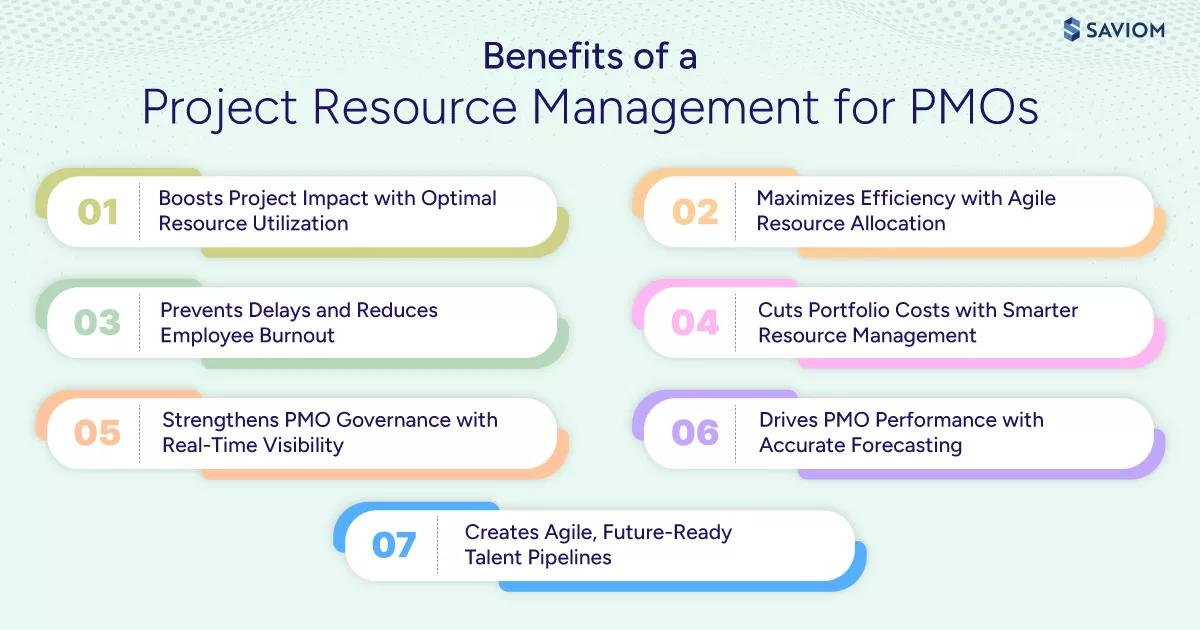
Optimizes Resource Utilization for Maximum Project Impact
With centralized resource data and continuous utilization tracking, PMOs can ensure that highly skilled and high-cost project resources are dedicated to the most critical, highest-impact initiatives. This maximizes resource ROI and improves overall project outcomes.
Enhances Resource Allocation Agility and Operational Efficiency
A well-defined PRM framework allows the PMO to quickly reassign resources when strategic priorities shift or unexpected project risks arise. This agility minimizes bench time, ensures swift project ramp-up, and improves operational efficiency across the portfolio.
Dive deeper: What is Overallocation of Resources? 6 Ways to Avoid It
Eliminates Project Delays and Employee Burnout
According to the 2024 BCG report, “48% of professionals from eight countries stated they are currently struggling with burnout.”
Effective workload balancing is key to prevent employee burnout. Project resource management helps PMOs in identifying individuals who are over-allocated or underutilized. This allows project resource managers to reallocate tasks or adjust timelines proactively, directly reducing schedule slippage and preserving team well-being.
Leverages Resource Management for Reducing Portfolio Cost
Accurate tracking of resource KPIs allows the PMO to monitor where money is actually being spent. By identifying underutilized talent, eliminating unnecessary external hiring, and upskilling internal resources, PRM drives cost efficiencies and helps keep the entire project portfolio within budget.
Keep reading: 15 Reasons Why Resource Management is Important
Improves PMO Governance with Resource Visibility
With real-time dashboards detailing resource availability, capacity, and current workload, the PMO gains the data needed to enforce consistent governance standards. This transparency supports objective decision-making and builds greater confidence with executive leadership.
Strengthens PMO Performance with Resource Forecasting
PRM’s forecasting capabilities allow the PMO to anticipate resource needs months or even a year in advance. By identifying future skills gaps and proactively planning resource requirements, PMOs can commit to strategic projects with confidence.
Learn more: What is Skill Matrix, and Why is it Important for Business Success?
Creates Agile, Future-Ready Talent Pipelines
By continuously tracking the skills and capacity of the current workforce, PRM highlights where training or cross-skilling is needed. It enables them to actively develop an agile, future-ready talent pipeline aligned with long-term strategic goals.
Next, let’s explore how PRM enables PMOs to drive portfolio prioritization and strengthen strategic alignment.
Driving Portfolio Prioritization and Strategic Alignment with Project Resource Management
The primary purpose of project portfolio management (PPM) is to ensure the organization is working on the right things. Project resource management is the mechanism that proves the right things can actually be done. Here is how:
Aligns Resource Allocation with Core Business Objectives
When resources are limited, PRM ensures the high-value projects are allocated the best resources first. This creates a direct link between resource availability and organizational goals, preventing low-value projects from consuming critical capacity.
Strategic Capacity Planning and Forecasting for High-Impact Initiatives
Effective PRM uses long-term resource capacity planning to assess whether the organization has the required skills (e.g., specific engineering expertise) to execute planned future initiatives. This prevents resource bottlenecks in high-impact areas before they materialize.
Measures and Improves Strategic Resource Utilization Across Projects
Project resource management provides metrics that track not just how much a resource is utilized, but also which strategic projects their time is spent on. This enables the organization to focus on delivering value rather than just being busy.
Continue reading: How to Measure Different Types of Resource Utilization? A Quick Guide
Drives Business Value with Data-Driven Resource Management
Resource management reports and utilization insights enable PMOs to engage in fact-based conversations with executives about project feasibility, priority trade-offs, and necessary staffing changes. This helps in driving business value through intelligent decision-making.
In the following section, we will see how capacity planning and what-if scenarios help optimize project portfolios.
Optimizing Project Portfolios with Capacity Planning and What-If Scenarios
Capacity planning and scenario modeling are two of the most powerful tools in the project resource management framework. Together, they enable PMOs to anticipate the future constraints, test alternatives, and mitigate risks early on. Here is how:
Capacity Planning for Project Portfolio Optimization
Capacity planning involves assessing the total available working hours or skill sets against the total demand from all future and active projects. Optimization occurs when these two forces are brought into sustainable balance, ensuring projects are neither understaffed nor over-committed.
Securing the Right Resources Exactly When Needed
By mapping resource demand against project milestones, PRM highlights critical resource gaps months in advance. This gives PMOs the lead time to hire, train, or procure necessary resources, ensuring that the right resources are available precisely when the project needs them.
What-If Scenarios for Smarter Portfolio Decisions
As per the Goodfirms 2025 survey report, “31.1% of firms have reduced their operating costs with the help of scenario planning.”
Scenario planning allows PMOs to test multiple future states, such as: “What if Project Alpha is delayed by three months?” or “What if we double the budget on Project Beta?” By visualizing the resource ripple effect of these changes, the PMO makes smarter, data-backed decisions.
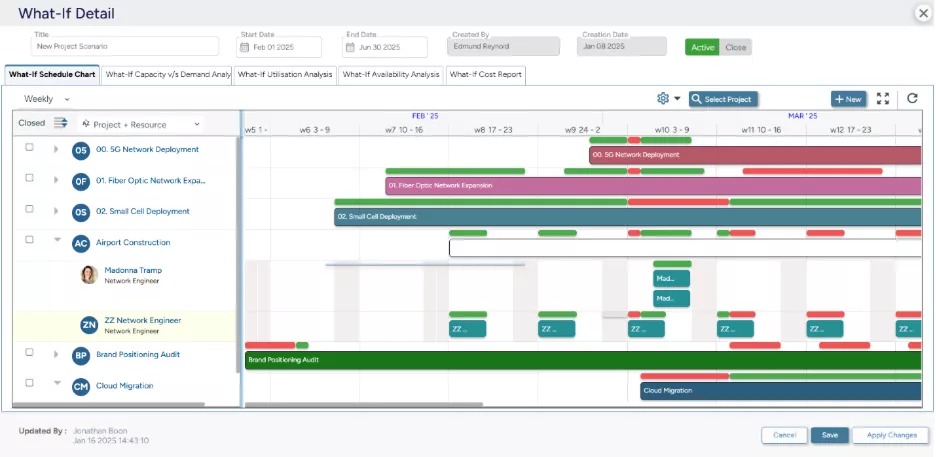 SAVIOM’s What-If Analysis helps managers assess and compare alternative plans for resource allocation, utilization, capacity vs. demand, and more to identify the best way forward.
SAVIOM’s What-If Analysis helps managers assess and compare alternative plans for resource allocation, utilization, capacity vs. demand, and more to identify the best way forward.
Balancing Resources Across Complex Project Portfolios
Project resource management tools help visualize the distribution of highly specialized or scarce resources across the entire portfolio. This prevents critical talent from being concentrated in one project and enables a balanced deployment, resulting in effective portfolio resource management.
Want to know more about capacity planning? Dive in:
- 5 Effective Steps to Measure Resource Capacity and Demand
- Top 9 Capacity Planning Challenges & Ways to Overcome Them
- The Fundamentals of Agile Capacity Planning: A Guide
We will now explore how effective project resource management helps manage project costs by optimizing resource spending.
Controlling Project Costs: Optimize Resource Spend and Variances
Resource costs, primarily labor, often represent the most significant portion of a project budget. Robust project resource planning practices serve as the primary defense against budget overruns. Let’s see how it helps:
Monitoring Cost Variances Across Project Portfolios
A well-defined project resource management plan allows the PMO to track actual resource usage against planned effort and budget. This provides immediate visibility into cost variances, enabling project resource managers to take corrective action before a minor deviation becomes a major financial crisis.
Further reading: Project Cost Management: Types, Importance, and Steps to Calculate It
Leveraging Resource Planning to Reduce Budget Overruns
By accurately anticipating future needs and allocating the right resources in advance, the PMO can avoid costly mistakes such as unplanned overtime, unnecessary contractor hiring, or penalties for delayed project completion. This proactive resource planning is a direct form of cost reduction.
Eliminating Last Minute Hiring and Escalating Cost
A lack of foresight into resource needs leads to rushed, expensive hiring or overreliance on high-rate external consultants. Demand forecasting and capacity planning enable PMO to onboard internal talent or negotiate better contract rates proactively, preventing unnecessary cost escalation.
Improving Budget Accuracy Through Resource Allocation Insights
When the PMO can reliably estimate the specific resources and the hours required for a project, the resulting budget estimate is far more accurate. Resource allocation insights directly translate into credible financial planning.
Using Blended Workforce to Minimize Resource Cost
Effective project resource management practices provide the data to utilize a blended workforce strategically, combining permanent staff (lower cost, higher continuity) with contingent workers/freelancers (higher cost, high flexibility). This optimization minimizes overall labor costs while meeting project needs.
Explore further: Understanding Cost Baseline in Project Management: Components, Benefits & Steps
Next, we will examine how project resource management helps minimize delivery delays and safeguard team well-being.
Preventing Project Delays and Team Burnout with Project Resource Management
The twin plagues of modern project management are missed deadlines and exhausted teams. PRM addresses both by focusing on sustainable workload management. Let’s find out how:
Reduces Team Burnout Through Balanced Resource Allocation
The fundamental goal of workload balancing in project resource management is to ensure that no team member is over-utilized. By maintaining healthy project resource utilization rates, PMOs can ensure a sustainable pace of work, which prevents team burnout.
Dive in: What is Workload Management, and How can it Boost Business Efficiency?
Improves Project Timelines with Proactive Conflict Resolution
The 2024 State of Conflict in the Workplace reports that “72% of organizations lack a formal policy to resolve conflicts.”
Resource conflicts—where two projects demand the same critical resource simultaneously—are a significant cause of delivery delays. Project resource management provides real-time visibility and a framework (via scenario modeling) that facilitates proactive conflict resolution, thereby improving project timelines.
Leverages Resource Demand Forecasting to Avoid Schedule Slippage
Forecasting highlights when resource demand exceeds available capacity. By identifying this shortfall in advance, the PMO can adjust schedules, defer lower-priority work, or initiate hiring. Thus, by effectively addressing capacity vs. demand gaps, they can avoid schedule slippage.
Aligns Resource Capacity with Project Deadlines
PRM forces an honest assessment: Can we realistically meet this deadline with our current resources? If the answer is no, the PMO can communicate constraints early and adjust delivery schedules proactively to maintain on-time delivery.
Utilizes Resource Management Tools to Minimize Project Risks
Resource data itself becomes a robust risk management tool. Over-allocation, skills gaps, and high turnover are all resource-driven risks. Project resource management surfaces these factors immediately, enabling mitigation before they affect the project.
Learn more: Resource Risks in Project Management: How to Mitigate Them?
Next, we’ll look at how to align resource management practices with Agile and Waterfall methodologies.
Aligning Resource Management with Agile and Waterfall
Resource management must adapt to the methodology being used. While PRM concepts remain constant, the application changes significantly between the predictive nature of Waterfall and the adaptive nature of Agile. Let’s explore how:
Understanding PRM in Agile and Waterfall Methodologies
- Waterfall PRM is typically predictive and detailed, involving long-term capacity forecasts and fixed allocations based on the project plan.
- Agile PRM is typically adaptive and lightweight, focusing on team velocity, ensuring stable team composition, and managing the resource pool’s overall capacity against the backlog.
Key Differences in Resource Allocation for Agile vs. Waterfall
In Waterfall, resource allocation is a detailed, upfront process. In Agile, the focus shifts from allocating individuals to allocating stable, cross-functional teams and managing their overall capacity (e.g., using story points or velocity).
Strategies to Align PRM with Agile Frameworks
Strategies include dedicating 100% capacity to stable teams (instead of juggling individuals) and focusing on resource requests for specialized skills needed by the team. It also includes assessing capacity reports based on velocity rather than individual utilization.
Best Practices for Integrating PRM into Waterfall Projects
This involves detailed resource calendars, accurate task duration estimates, and formal conflict resolution procedures when project schedules inevitably change. The focus is on precision and detailed utilization tracking.
Balancing Flexibility and Control in Hybrid Resource Management
Many organizations use a Hybrid approach. The best practice is to use PRM’s long-term capacity planning for the entire portfolio (control), while allowing individual execution teams to self-organize and manage their daily workload (flexibility).
Explore more: Agile vs. Waterfall Project Management: A Comparative Analysis
In the subsequent section, we will deep dive into the best practices for implementing a robust project resource management framework.
Best Practices for Implementing Project Resource Management Across Teams and Portfolios
Implementing project resource management isn’t just about installing software; it’s a major organizational change that requires structure, governance, and buy-in. Here are the best practices to follow:
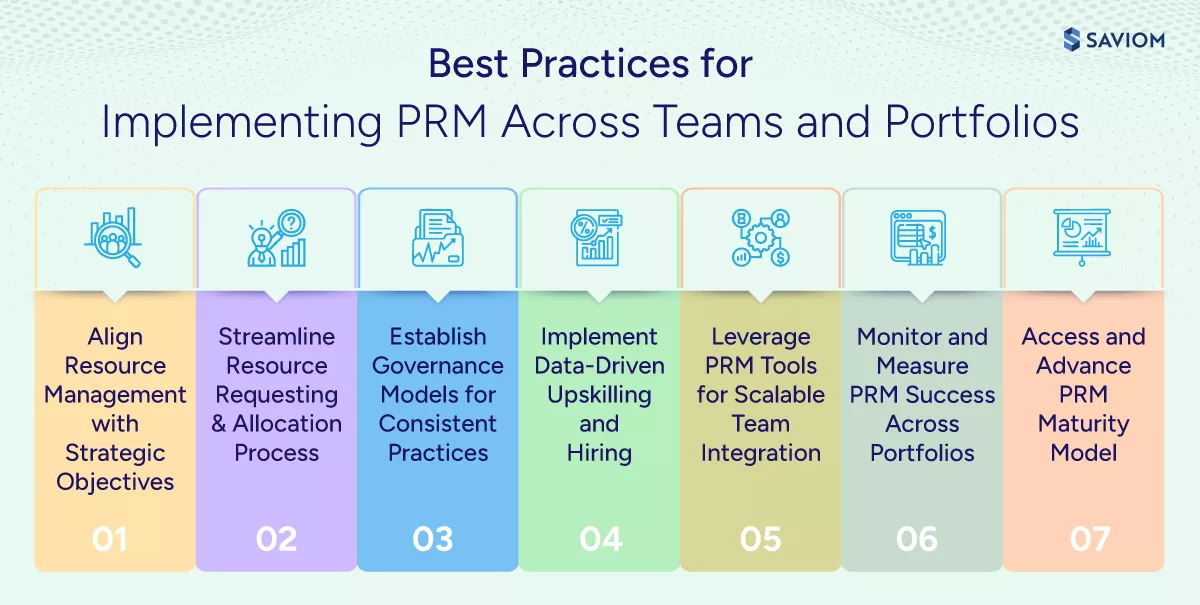
Align Resource Management with Strategic Objectives
Before selecting tools or processes, ensure your project resource management framework is designed to prioritize and enable projects that directly support the organization’s top three strategic objectives.
Streamline Resource Requesting and Allocation Process
Establish a simple, standardized, and transparent workflow for requesting, approving, and confirming project resources. This reduces friction and improves collaboration across project teams and resource managers.
Build Governance Models for Resource Management Consistency
Formalize who owns the resource data (PMO), who approves major allocations (Steering Committee), and how conflicts are resolved. Clear governance models ensure consistency across all portfolios.
Implement Data-Driven Upskilling and Hiring
As per SHRM’s Talent Trends 2025 report, “69% of organizations still struggle to fill roles, making targeted upskilling & skill-based hiring a mandate for closing gaps.”
Use resource capacity data to identify skills gaps. This allows HR/L&D functions to proactively initiate data-driven upskilling and hiring plans, ensuring the organization’s talent evolves with its strategy.
Leverage PRM Tools for Scalable Team Integration
Select project resource management tools that are robust enough to manage complex portfolios but flexible enough to serve individual team needs. The tool must provide the necessary visibility and integration for scalability.
Monitor and Measure PRM Success Across Portfolios
Define resource management KPIs for PRM success, such as resource utilization rate, percentage of projects completed on time/budget, and the number of resource conflicts resolved proactively.
Access and Advance PRM Maturity Model
Regularly assess your organization’s PRM maturity (e.g., Level 1: Non-existence to Level 6: Holistic). Use this assessment to guide incremental improvements and advance resource management capability.
Further reading: How to Accelerate Your Resource Management Maturity Model?
Having understood project resource management best practices, let us see how to select the appropriate tool for effective resource management.
Choosing the Right Platform for Project Resource Management
Selecting the appropriate PRM platform is critical, as it operationalizes your entire strategy. This is a strategic investment, not just a technical purchase. Here is how to evaluate and pick the right tool:
Key Features Comparison: Evaluating Must-Have Functionality in PRM Tools
A robust project resource management system must include features such as a centralized resource pool, drag-and-drop allocation, capacity planning, what-if scenario modeling, utilization optimization, skills management, and time tracking.
SAVIOM’s 5th gen resource management software delivers all these essentials plus advanced capabilities like KPI forecasting, embedded heatmaps, and early warning alerts, enabling PMOs to manage complex portfolios with precision.
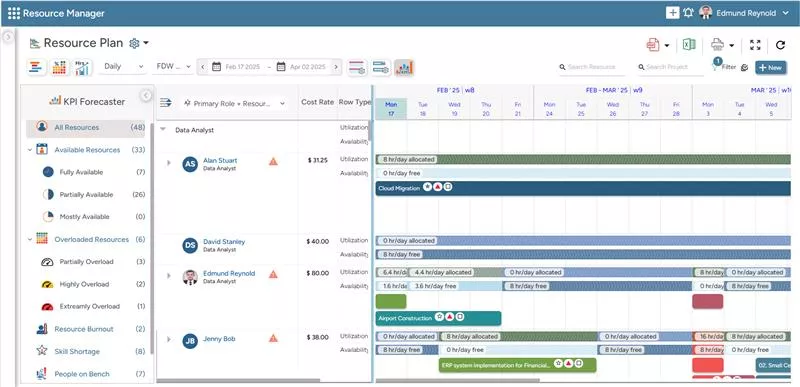 SAVIOM’s KPI Forecaster provides visibility into critical metrics such as utilization, availability, and bench time, helping managers anticipate risks, track progress against maturity goals, and take proactive steps to improve efficiency.
SAVIOM’s KPI Forecaster provides visibility into critical metrics such as utilization, availability, and bench time, helping managers anticipate risks, track progress against maturity goals, and take proactive steps to improve efficiency.
Integration Capabilities: Ensuring Seamless Data Flow with Existing Project Systems
The best project resource management platforms do not stand alone. They must seamlessly integrate with your existing PPM, HR, accounting, and task management systems to ensure data accuracy and avoid duplicate entry.
SAVIOM’s advanced solution consolidates data from multiple applications, providing a single source of truth for resource planning in project management.
Scalability and Future-Proofing: Selecting a PRM Platform for Organizational Growth
Choose a platform that can easily accommodate growth in users, projects, and complexity. Future-proofing means selecting a vendor that actively develops new features aligned with market trends (such as AI/ML).
SAVIOM’s highly configurable architecture and features, such as intelligent KPI forecasting and scenario-based planning, make it a future-ready investment for long-term PMO transformation.
User Experience and Adoption: Prioritizing Intuitive Interfaces for Team Buy-in
If the platform is cumbersome, people won’t use it, and the data will be inaccurate. Intuitive user experience (UX) is paramount for achieving high user adoption among project managers, resource managers, and individual contributors.
SAVIOM’s interface is built for ease of use, with visual dashboards, drag-and-drop scheduling, and simple workflows to ensure fast adoption.
Ensuring Data Security and PMO Compliance in PRM Platforms
For sensitive personnel and cost data, ensure the PRM platform meets necessary regulatory and data security standards, including PMO compliance mandates.
SAVIOM supports enterprise-grade access controls, secure data handling, audit trails, and governance-ready configurations, ensuring compliance with internal and industry standards.
Customization Options for Diverse Project Portfolios Success
If your portfolios include a mix of Agile, Waterfall, and maintenance work, the platform must offer customization options to handle different resource allocation methods and reporting needs.
SAVIOM’s fully configurable dashboards, reports, and workflows allow PMOs to tailor the tool to varied portfolio requirements and stakeholder expectations.
Vendor Evaluation: Cost, Support, and Long-Term Partnership for PRM Success
Look beyond the immediate price tag. Assess the vendor’s customer support, training offerings, and their commitment to a long-term partnership. The quality of support determines how quickly you resolve issues and implement new features.
With over two decades of experience and clients across 50+ countries, including Verizon, Fujitsu, ABB, and Grant Thornton, SAVIOM is recognized as a global pioneer in resource management, offering unparalleled support and domain expertise.
Explore more: Transforming PMOs with 5th Gen Resource Management
Finally, let’s explore the key trends that are redefining the future of project resource management.
Emerging Trends Shaping the Future of Project Resource Management
The field of PRM is rapidly evolving, driven by new technologies and changes in the modern workforce. Staying ahead of these trends is key to maintaining a high-performing PMO.
AI and Automation in Project Resource Management
Artificial Intelligence (AI) is now automating routine PRM tasks like initial resource matching based on skills/availability and automatically re-forecasting project timelines based on real-time utilization data. This frees resource managers for strategic work.
Early Detection and Mitigation of Potential Project Risks
Advanced analytics are moving beyond simply reporting data to predicting risks. AI can flag projects with a high probability of delay or employee burnout based on historical resource consumption patterns, enabling early risk mitigation.
Dive in: What is Enterprise Risk Management? 9 Key Steps to Implement
Real-Time Resource Visibility Across Teams and Portfolios
The expectation is shifting from weekly reports to instantaneous, real-time visibility. Modern platforms integrate with execution tools to provide live updates on resource availability and project progress, enabling PMOs to make quick, informed decisions.
Integration of PRM with Enterprise Portfolio Management Tools
The siloed approach is disappearing. Project resource management is increasingly embedded in comprehensive Enterprise Portfolio Management (EPM) tools, enabling strategic decisions to be reflected in resource assignments instantly.
Remote Workforce Management and Global Resource Allocation
The rise of remote and hybrid work demands project resource management tools capable of managing global resource pools, accounting for time zone differences, local labor laws, and asynchronous collaboration styles.
Data-Driven Decision Making in Resource Optimization
The future is about using large datasets—historical project resource utilization, actual task duration trends, and skill inventories—to forecast demand, optimize allocation, and prioritize the right initiatives.
Agile Resource Management for Dynamic Project Environments
As organizations become more agile, project resource management must support fluidity. This means systems that prioritize team stability and capacity management over rigid, individual-level scheduling.
Conclusion: Mastering PRM for Strategic Command
Project Resource Management (PRM) is no longer a scheduling chore; it is the strategic foundation upon which every successful project and portfolio is built. By mastering the core components—capacity planning, centralized pools, and scenario modeling—you empower your PMO to become a true partner to the business.
PRM drives PMO transformation by providing the clarity needed to:
- Stop: Working on low-value projects that consume valuable talent.
- Start: Proactively identifying and filling future skills gaps.
- Ensure: That every critical project has the right resources at the right time.
The roadmap is clear: implement standardized processes, leverage a modern PRM platform with robust integration, and continuously refine your approach based on data. The result will be not just projects delivered, but strategic value delivered consistently, transforming your organization’s delivery capability for years to come.
